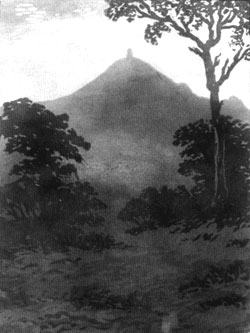John & Katharine Maltwood Collection
| View the Collection |
History of the Collection |
John & Katharine Maltwood |
Information Resources |
The Maltwoods Introduction
Katharine Maltwood Biography
Early Sculpture
Post-War Works Glastonbury Zodiac - Arthurian Mythology - Discovering the Zodiac - Theory of the Zodiac - Earning Recognition - Ties to Freemasonry - Chilton Priory Life in Victoria, B.C. Monograph (pdf 1.14 MB)
About Us Contact Us Visit Us Site Map

The Glastonbury Zodiac - Part 3: Theory of the Zodiac | ||
|
Over the years her extensive investigations involved topics such as astronomy, historical astrology, archaeology, comparative mythology, folklore and esotericism. She became well acquainted with the history of Celtic Druid cults, ancient Mesopotamia, Egypt, Greece and Phoenicia and also found that much of the folklore, traditions and place names in the Glastonbury area were associated with the Giants. Gradually she evolved a theory explaining the origins and significance of the terrestial zodiac. She dated it to c. 2700 B.C. when the sun at the spring equinox lay in the eye of the Bull effigy, Taurus, to which the Archer or sun-god Hercules and several other symbols point. In her opinion the zodiac was created upon ground already sacred to the worship of the Egyptian god of the dead, Osiris, and much of the mythology of the figures corresponded with Egyptian beliefs. The effigies were created, she maintained, by priests of ancient times who held unique scientific, religious, artistic and agricultural knowledge, shrouded in symbolism, the meaning of which they revealed only to their initiates. This knowledge, symbolized in the zodiac, was brought to Britain by Sumer-Chaldean priests from the Euphrates Valley who laid out the zodiac as a great nature temple of the stars in order to preserve it forever in a manner readily visible to the initiates. As evidence she cited that in Welsh mythology this Vale of Avalon was regarded initially as "the Kingdom of the Dead" and afterwards "an earthly paradise in the Western Seas" before it became the Christian Grail. Katharine Maltwood claimed the zodiacal temple was "looked upon in its beginning as the 'cauldron of unfailing supply': it had three properties - inexhaustibility, inspiration and regeneration." Its builders linked earth with heaven in a direct cosmological unity that created the harmony of a now vanished Golden age. She wrote that "when conceived this Paradise Garden was indeed Heaven on Earth". The zodiacal myths are an allegory of the sun's annual wanderings among the signs. In these myths the sun-god escapes death in a sacred ship. She believed the ancient British priesthood, incorporating the Sumer-Chaldeans, called this ship and eventually the associated zodiac, the Caer Sidi. Still later the whole cult, with the priesthood's confined circle of arts and sciences, became the cup of wisdom, making the transposition from ship or vessel to cup.
The central god subsequently became Arthur, perpetuating the real or imaginary chief who defended the Britains from the heathen and who, like the sun after his epic annual decline, would come again. When Joseph of Arimethea brought Christianity and the Holy Grail to Britain, the Grail inevitably absorbed the cup of wisdom. Similarly, the astronomical myths became the adventures of a great Christian King Arthur and his knights (the sun and constellations), the round zodiac merged into the Round Table and the country of the giants into the Kingdom of Logres; while the quest of the initiates for the cup of wisdom became the quest of the Holy Grail.54 Katharine Maltwood was convinced that the knowledge embodied in the zodiac at Glastonbury, in its reflection of God's Universe and its laws, transcended and preceded all other compositions including the Masonic Temple of Solomon.55 It was the all important key to the evolution of human consciousness and was deliberately designed to be passed on, down through the ages to be rediscovered at the appropriate time, presumably this century. Although she acknowledges that Madame Blavatsky predicted the wisdom of the ages was concealed in allegorical mythologies and suggested Britain as the place of a colossal zodiac Katharine Maltwood maintained "this masterpiece of art and science" was lost sight of until her discovery in 1925. The tremendous significance she attached to the ancient effigies is revealed in her books on the subject:
In her quest for the Holy Grail she followed in the tradition of British visionaries like Blake, Wordsworth, Coleridge and Tennyson. The feeling they all shared was of some forgotten secret. They sought to penetrate the layers of time that covered the face of the country and glimpsed a remote golden age of science, poetry and religion when Britain was a holy land under enchantment. Katharine Maltwood was convinced she had recovered the lost key to these British mysteries and that the ancient wisdom embodied in the zodiac would restore the true traditions, glory and destiny of the race. In the Enchantments of Britain she concluded:
All content on this page is copyright © 30 January, 2006 |
||
